The strangest Christmas traditions from around the world revealed
- Krampus the demon, a bad-tempered Yule Cat, and the Mexican night of the radishes
- Unusual festive rituals include Krampus – a demonic chaser of children
- The Mexican city of Oaxaca celebrates its favorite Night of the Radishes
- Iceland has the angry ‘Yule Cat’ – which preys on the shabbily dressed
- Catalans are prone to placing an unsavory item in their nativity set
Christmas, so we are told, is a time for the more genteel things in life. For big green fir trees laden with baubles, chestnuts roasting on open fires, and the sound of carols in the street. For all sorts of traditions, really.
And so it is. Of course, that depends on how you define the idea of ‘tradition’.
Because, in some corners of the world, Christmas rituals can be a little on the unusual side. And a little (or a lot) on the sinister side.
Step this way for encounters with the anti-Santa, a cat with fashion issues and a lot of very red Spanish underwear. Happy Christmas all around.
Krampus

Where: Austria, Germany, the Czech Republic, Slovakia, Slovenia
Christmas is meant to be a festival when kids are enchanted by the magic of the season. Not scared to death by the sort of terrifying figure who looks like he has escaped from a (very) low-budget horror movie.
Still, there is something striking about Krampus – a quasi-demonic fellow, and a dark flip-side to St Nicholas (the basis for the concept of Father Christmas), who preys on youngsters in Central Europe. A be-horned chap with cloven hooves, he reputedly stomps around the streets on the night of December 5th, armed with rusty chains and bells, searching for children who have misbehaved.
Frankly, he seems a creature of such nightmarish proportions that he is more likely to send your six-year-old niece fleeing into years of therapy than induce any sort of good behavior.
And some people in the Germanic world clearly agree.
Krampus was banned in Austria in the 1930s for being, well, a bit much. On the other hand, if your five-year-old is flatly refusing to go to bed on Christmas Eve, the threat of an Austrian devil coming round to scream in his face should have him charging upstairs as if his little feet are jet-propelled.
Jólakötturinn
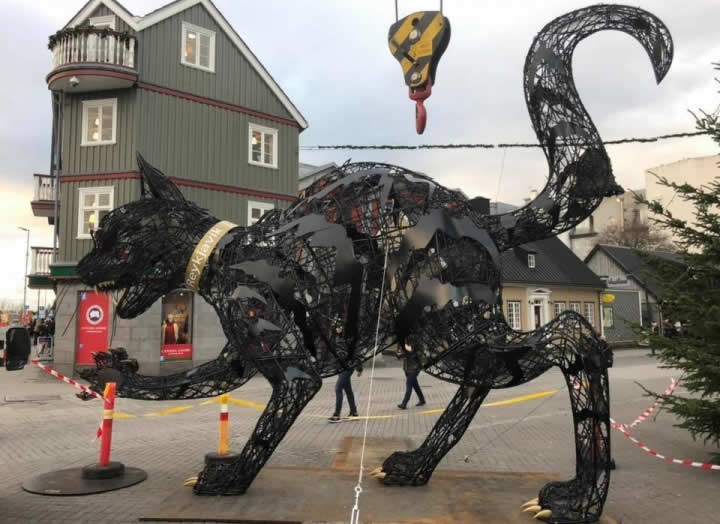
Where: Iceland
Another member of the Are You Sure This Is A Good Idea? Christmas Club is Iceland’s Jólakötturinn – a mythical beast whose name translates as ‘Yule Cat’.
This sounds suitably sparkly and festive, right? A sort of friendly, loveable feline who lollops up to your house during the winter months, bringing presents for all, right? And not those presents that your cat normally brings – decapitated mice, a half-chewed frog, something sour and unidentifiable that may have come from next door’s bin. Proper presents. Right?
Wrong. The Jólakötturinn is a huge, angry monster who attacks the badly dressed, like some sort of be-whiskered Gok Wan with terrible, terrible anger issues.
He emerged from Icelandic farm folklore in medieval times, seemingly as a way to motivate workers during autumn, when wool was being processed ahead of the cold Scandinavian winter. Those who worked hard would be rewarded with new clothes. Those who did not would have to make do with that year’s rags – leaving them to the wrath of the Yule Cat, who apparently has a hatred of the scruffy and the non-smart. Which seems logical – and not at all weird.
So if your grandmother buys you a Gap voucher, she is trying to save you from the sharp claws of a frosty moggy. And definitely hasn’t bought you a gift shorn of all imagination.
Joulupukki
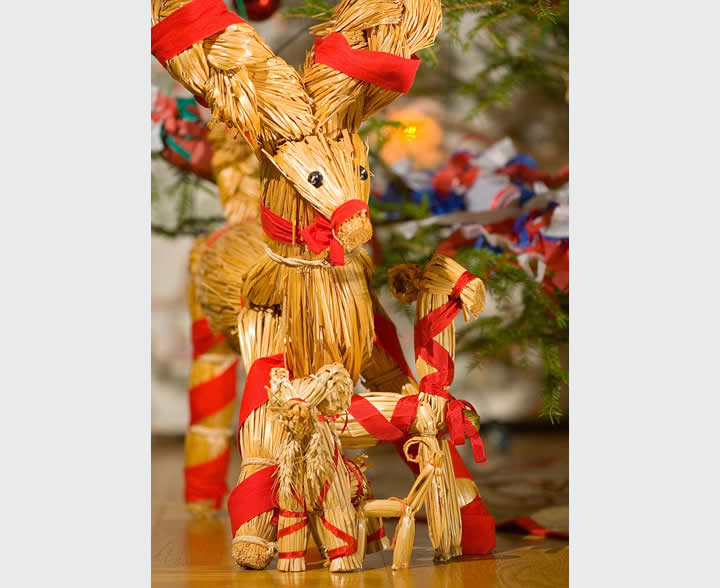
Where: Finland
And what of Finland, where Joulupukki – ‘The Christmas Goat’ – is part of the festive tapestry. What could this be? A vicious mountain animal with horns made of steel, three glowing eyes, and a dreadful personality – who brings you boring presents, devours the turkey, guzzles all the sherry, and knocks over the Christmas tree with one gnarly hoof?
Not quite. Joulupukki is a thinly veiled version of Father Christmas – a gift-giver linked to the Norse god Odin who arrives on Christmas Eve and delivers his presents by coming through the front door instead of forcing his way down the chimney. Which seem wholly sensible. He also has a sleigh pulled by non-flying reindeer. Which is a lot more realistic.
You can often see Joulupukki under Finnish Christmas trees, represented as a straw goat.
Caganer
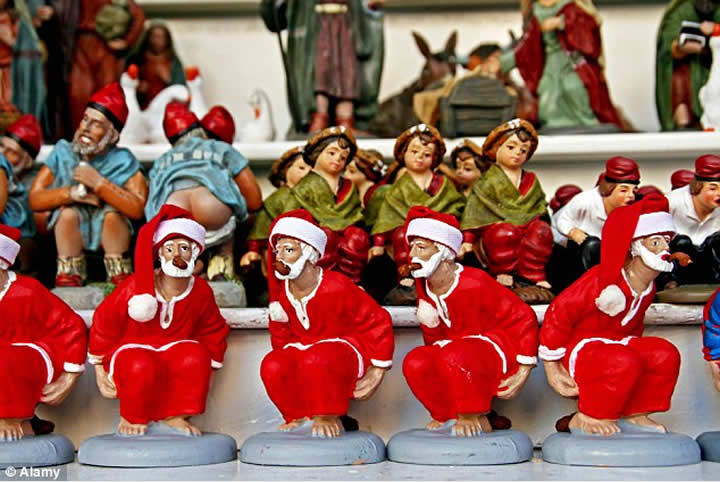
Where: Spain
The make-up of a Christmas nativity scene is a thing fairly set in stone, with not much room for variation. The newly-born Jesus and family. Shepherds. A few sheep. An angel or two. Wise Men or Kings, depending on what you want to call them, as long as they are three in number – no more, no less. Perhaps a donkey skulking at the back of the stable.
Oh, and a crude, stooped person doing something unpalatable – the sort of activity that should absolutely be confined to a toilet – in one straw-laden corner.
At least, that is the case in Catalonia, where the ‘caganer’ is a fundamental part of the nativity tradition. A caganer being, of course, a small statuette doing its business in full public view. If you are witty as well as Catalan, this might be a figurine of some member of the Spanish royal family, a politician you don’t much like, or a very bad Santa. Ah Barcelona, a city of such a culture.
Christmas rollerskates

Where: Venezuela
Of all the overseas festive quirks that do not translate to Britain, the one which plays out upon the streets of the Venezuelan capital is the most unworkable.
Think the combination of icy gritted surfaces and small wheels, seasoned with general tut-tutting about health and safety – and then think of the fun they have in Caracas, where the build up to the big day sees city residents don rollerskates and roll happily to mass.
You might glimpse this very merry madness between 16 and 24 December, but certainly on Christmas Eve, when roads are even closed down to allow the fast-moving throng through on its way to church.
Festive spiders
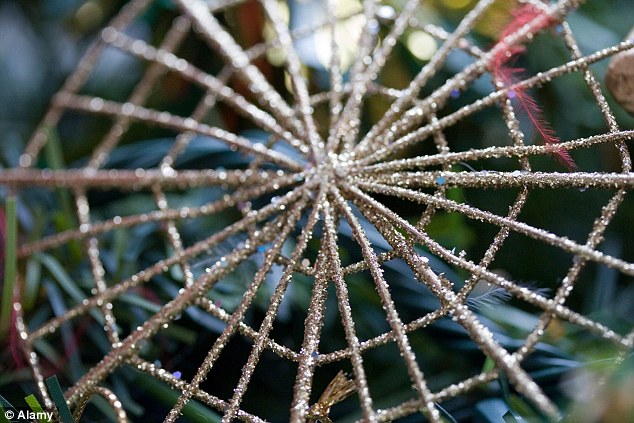
Where: Ukraine
For many people, the idea of a large arachnid clambering all over their possessions would be enough to induce a screaming fit. But the humble spider has a more favorable image in Ukraine. At least when it comes to Christmas. It also wins special praise from those who are too lazy to decorate their own tree and would rather someone else did it for them.
Ukrainian legend tells the story of an impoverished widow with 65 children (or 16. Or six. Whatever) who could not afford to add a dash of Christmas sparkle to the fir tree which stood outside her country hovel. Cue an eight-legged angel which, in the dark of Christmas Eve, came down and weaved a fine silvery web all over the branches – which sparkled in the dawn light.
This definitely caused the kids to ooh and aah in unison – and definitely did not cause them to run inside shrieking something about a massive tarantula. Nor did it cause the widow to go straight outside with a large brush and bash the poor beast into bits.
Ukrainian Christmas trees sometimes sport spider-web decorations as a result. Made from bright, twinkly bits of wood, carefully crafted by humans, and not made by actual spiders.
Reveillon
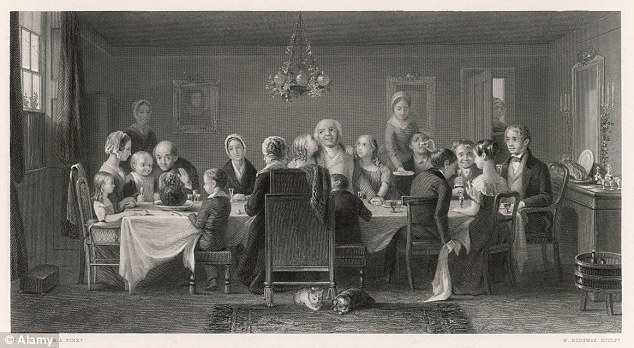
Where: France (but also New Orleans. And Quebec)
Not for the French-speaking world the gluttonous ceremony of Christmas Dinner – with its vast overindulgence in roast potatoes, stuffing, and mince pies.
No, for some of our Gallic cousins, it is the gluttonous ceremony of “reveillon”– a Christmas Eve banquet to end all banquets. The idea is to stay awake (roughly the translation of the word) until after midnight, cramming as much luxurious grub into your face as possible.
This may include the stomach-stretching prospect of the 13 desserts. Yes, 13 – one for each of Jesus and the 12 Apostles. Which does sound a little bit Eastery rather than a bit Christmassy – but who are we to quibble with the French when it comes to matters of a culinary nature?
Night of the Radishes

Where: Mexico
Your mother always told you not to play with your vegetables. Your mother, presumably, was not Mexican. And if she was, she clearly did not hail from Oaxaca.
For if she did, she would definitely have told you to play with your vegetables. Or, at least, any radishes that you may have had to hand.
Because, in this southerly Mexican city, December 23rd witnesses the Noche de Rabanos (Night of the Radishes) – a formidable event which sees these harmless, rather bland pink-and white garnishers of salads carved into nativity figures in an edible tribute to the Christmas story.
This niche skill is even recognized, with the finest radish statues displayed in the city’s main square, with prizes for the best.
Simbang Gabi
Where: The Philippines
Of course, there are still some parts of the planet where Christmas is not a time for glib amusement, drunken parties, and presents you take back to the shop on Boxing Day.
It is a time for religious observance and quiet decorum.
One of those places is the Philippines – a deeply Catholic country, where the approach to Christmas is treated with a good deal of respect via the process of Simbang Gabi.
This is a series of night masses, staged at hours that might be deemed ungodly – if that wasn’t an execrable pun. Hours that might be as ungodly as three in the morning – a by-product of an agricultural economy where, in years past, farmworkers needed to be in the rice fields at first light, and could not skip work to say their prayers. Thus the idea of the very early service – which lingers to this day between December 16th and 24th. The compensation for those whose rise long before the dawn is a hearty breakfast once mass has finished – with chicken porridge a favorite.
Special knickers
Where: Spain
Technically, this is a New Year ritual – but New Year comes under the Twelve Days of Christmas, so it still counts. In certain parts of Spain, notably Valencia, it is deemed serendipitous to wear unabashedly red underwear on New Year’s Eve.
This will reputedly bring good luck in the coming 12 months. The village of La Font de la Figuera makes a party of the whole thing, holding a New Year’s Eve run where competitors are clad only in their (red) smalls. It is – of course – warmer in Spain in December than it is in Britain.
